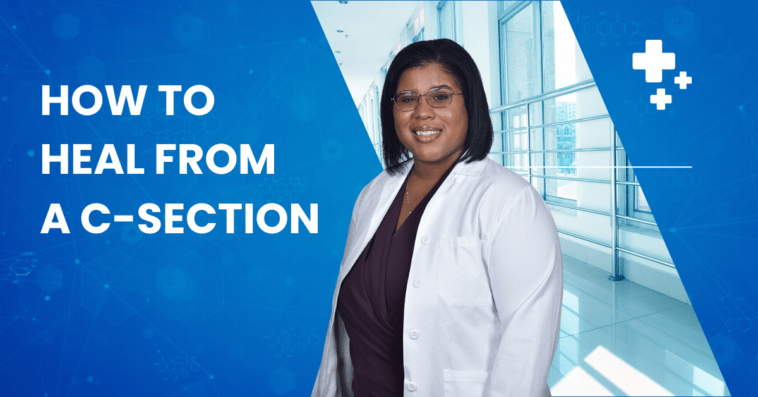Caring for a newborn can feel overwhelming, especially if you had your baby via C-section. It can be even harder to heal. Knowing what to expect can help in your first days and weeks of becoming a mother.
If you adhere to your doctor’s orders, recovering from a C-section can be relatively easy and painless. You can expect the healing process to take six weeks instead of the four weeks following a vaginal birth.
First Days After Birth
When you have a C-section, you likely will stay in the hospital for one or two days. During these two days, the discomfort from your surgery will be the strongest, and nurses and doctors will regularly monitor your vital signs and manage your pain levels.
Some women only need ibuprofen or acetaminophen, while some may need stronger medications. If you are experiencing excessive discomfort, speak up so your doctor can adjust your medicine.
Doctors will also check your incisions for infection. They will also assess the uterus for appropriate firmness, tone, and contractions, indicating proper healing.
You can begin walking around your hospital room or hallway as early as six hours post-surgery or when it feels comfortable, which aids in faster recovery by:
● Increasing blood flow and oxygen to tissues
● Decreasing the risk of blood clots
● Releasing endorphins
● Boosting gut motility
● Lowering the risk of constipation
Two Weeks After Birth
Your doctor will provide instructions on how to look after your incision at home, with advice varying based on whether they used stitches, staples, or glue. To promote faster healing, you should:
● Keep the incision clean and dry to avoid infection. That means no baths or swimming.
● If you are taking narcotics as part of your recovery, restrict driving.
● Eat well.
Signs to watch for:
● Fevers
● Chills
● Night sweats
● Heavy bleeding, defined as soaking through more than one pad in an hour
● Redness or oozing from the incision
All the signs point to a surgical-site infection, and you should call your doctor. You could be fighting off endometritis, inflammation of the uterine lining, or another problem that needs medical attention.
Most of all, listen to your body. If the pain in your body seems unusual or the prescribed pain relief proves insufficient, contact your physician.
Additionally, schedule a follow-up appointment at the doctor’s office within one to two weeks after your cesarean birth to confirm that recovery is progressing smoothly.
Six Weeks After Birth
You likely will be feeling better, but you should still be careful. Avoid climbing the stairs as much as possible, as that movement increases abdominal pressure. But staying in bed slows healing time and increases your risk of developing a blood clot in your legs or lungs. The answer is to find that balance between light activity and nothing.
Now is a great time to have a family member or friend visit and help around the house by fetching items from upstairs or limiting your physical workload since you are not supposed to lift anything exceeding 20 pounds. Do not try to be a superhero and overdo it, which could delay healing.
If you experience swollen extremities, shortness of breath, fever or excessive vaginal bleeding, go to the ER. Oozing or foul odor from your incision site warrants a visit to your OB-GYN.
Signs of preeclampsia, which can show up any time during the six weeks following childbirth, include:
● Persistent headache
● Blurry vision
● Abdominal pain
When left unmonitored, preeclampsia, a hypertension disorder, can cause harm to various organs, including the kidneys.
For most women, healing has wrapped up around the six-week mark. One last visit to your OB-GYN is typical at this time. A clean bill of health marks the end of your pregnancy and childbirth journey.
Dr. Carhine Pierre-Lambert is a board-certified OB-GYN with Orlando Health Physician Associates. She offers a range of care for patients from adolescence to menopause. Her areas of specialty include:
· Obstetrics
· Gynecology
· Family planning
· Female reproductive health
· Pregnancy wellness
· Abnormal bleeding
· Fibroid management
· Menopausal care
Dr. Pierre-Lambert’s Training
Dr. Pierre-Lambert earned her medical degree from the State University of New York at Buffalo School of Medicine after receiving her bachelor’s degree in neuroscience at New York University. She completed her residency in obstetrics and gynecology at Westchester Medical Center/Metropolitan Hospital Center at New York Medical College in Valhalla, where she served as chief resident.
About Dr. Pierre-Lambert
Dr. Pierre-Lambert grew up in Rockland County, New York, outside New York City. She moved with her family to Central Florida in 2013 and has been practicing here ever since. Dr. Pierre-Lambert is a fellow of the American College of Obstetrics and Gynecology. She is fluent in English, French and Spanish.



Comments